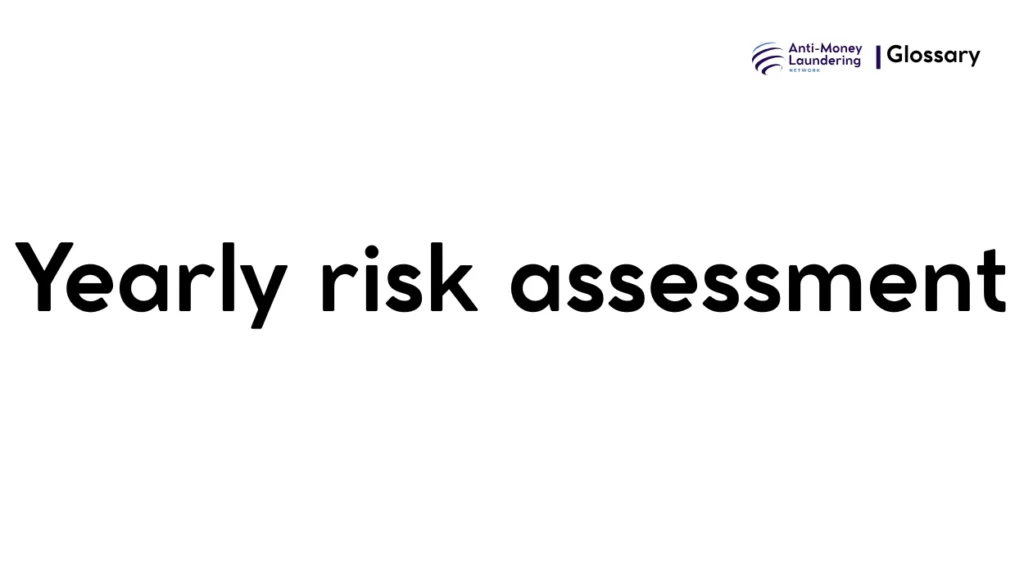Definition
Yearly Risk Assessment in AML is a systematic, periodic process where financial institutions and regulated entities identify, evaluate, and document the money laundering and terrorist financing risks they face. Conducted annually, this assessment evaluates current controls’ effectiveness and guides the institution’s AML strategy to mitigate those risks proactively.
Purpose and Regulatory Basis
Role in AML
Yearly risk assessments help institutions:
- Prioritize AML efforts based on risk exposure.
- Allocate resources efficiently.
- Stay compliant with evolving regulatory requirements.
Why it Matters
Money laundering methods and risks constantly evolve; an annual review ensures institutions adapt and fortify defenses against emerging threats.
Key Regulations
- Financial Action Task Force (FATF): Recommends regular risk assessments as part of a risk-based approach.
- USA PATRIOT Act: Mandates institutions to maintain effective AML programs including risk assessments.
- EU Anti-Money Laundering Directives (AMLD): Require identification and assessment of risks at regular intervals, typically annually.
When and How it Applies
Real-World Use Cases
- Annual internal AML audits.
- Compliance with regulatory mandates.
- Triggered by significant business changes (M&A, new product lines).
Triggers and Examples
- Significant increase in high-risk customer onboarding.
- Introduction of cross-border transactions.
- Changes in geographic exposure to sanctioned countries.
Types or Variants
Risk Assessment Variants
- Institution-wide Risk Assessment: Comprehensive review encompassing all business lines.
- Product/Service-Specific Risk Assessment: Focus on specific products or services with distinct risk profiles.
- Geographic Risk Assessment: Evaluates risks related to operating in certain high-risk jurisdictions.
Procedures and Implementation
Steps to Comply
- Risk Identification: Compile data on customers, products, services, and geographic exposure.
- Risk Analysis: Use qualitative and quantitative methods to evaluate risk levels.
- Risk Evaluation: Determine which risks are acceptable or require mitigation.
- Control Implementation: Develop or enhance controls based on risk findings.
- Documentation: Record assessment results and actions taken.
- Senior Management Approval: Obtain sign-off and integrate into compliance reporting.
Systems and Controls
- Automated monitoring tools.
- Customer due diligence (CDD) upgrades.
- Transaction monitoring systems tuned to risk findings.
Impact on Customers/Clients
- Enhanced due diligence may extend onboarding timelines.
- Customers in higher-risk categories face increased scrutiny.
- Right to privacy balanced against regulatory obligations.
Duration, Review, and Resolution
- Timeframes: Typically completed annually.
- Review Process: Continuous monitoring between formal yearly assessments.
- Ongoing Obligations: Update controls and procedures as new risks emerge.
Reporting and Compliance Duties
- Maintain detailed documentation for regulators.
- Report significant findings to senior management.
- Submit updates to regulatory bodies as required.
- Penalties for non-compliance can include fines, sanctions, or reputational damage.
Related AML Terms
- Customer Due Diligence (CDD)
- Enhanced Due Diligence (EDD)
- Suspicious Activity Reporting (SAR)
- Risk-Based Approach (RBA)
Challenges and Best Practices
Common Issues
- Data quality and integration challenges.
- Resistance to change within the organization.
- Complexity in assessing emerging risks.
Best Practices
- Use cross-functional teams for assessment.
- Employ advanced analytics and risk scoring tools.
- Continuous staff training and awareness.
Recent Developments
- Increased use of AI and machine learning for risk detection.
- Regulatory focus on integrating environmental, social, and governance (ESG) factors.
- Growing emphasis on real-time risk assessment over static yearly models.
Yearly Risk Assessment is a cornerstone of effective AML compliance, enabling institutions to identify and manage evolving risks systematically. It ensures regulatory adherence, supports sound decision-making, and protects the financial system against abuse.

